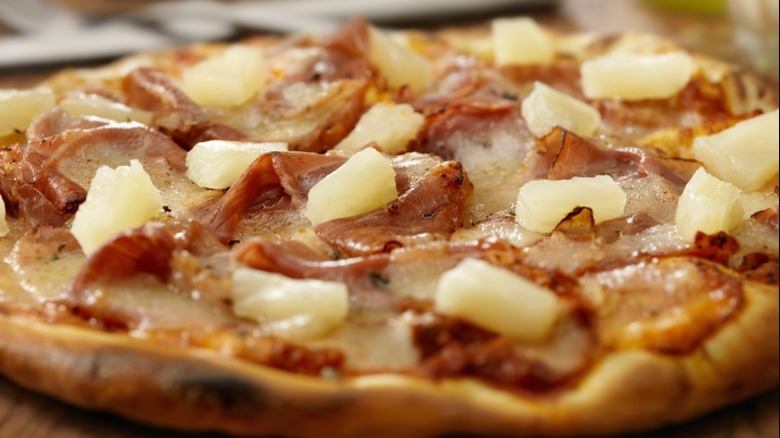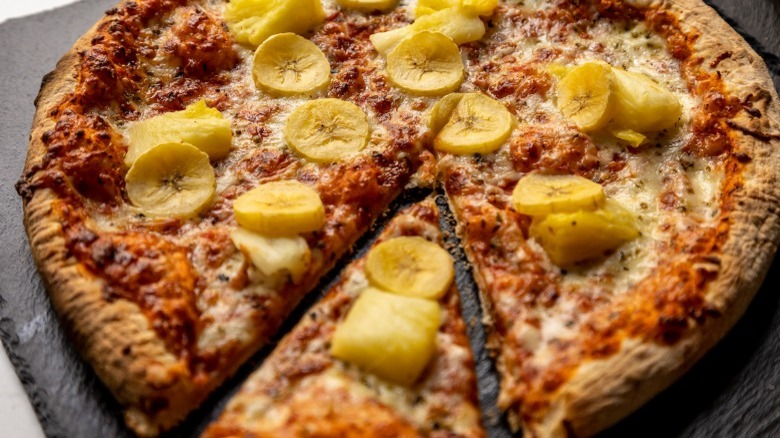How Pineapple Became A Controversial Pizza Ingredient
If you ask someone for their hottest food take, chances are good it might be about the infamous pineapple and pizza combination. Hawaiian pizza, with its pineapple chunks and sliced ham atop basic dough, tomato sauce, and cheese, strikes some as an objectively odd pairing. It's one of the most divisive food combinations out there — some find even the thought of it disgusting, while others would go to battle defending it.
So, why did it become so controversial? When pineapple was first added to pizza in the 1960s, its creator was trying to capitalize on the Tiki-obsessed population of the time. Although some appreciate experimental food, others are purists, and pineapple on pizza is absolutely an affront to culinary norms in places known for their simple pies, such as Naples, Italy. There are also people who dislike pineapple's texture, or simply find the idea of fruit paired with hot cheese unappealing. The topping has become so controversial that even world leaders have weighed in: Justin Trudeau, Canada's Prime Minister, defended it, while Iceland's president threatened to ban the pie.
Where did pineapple on pizza come from?
Although dubbed "Hawaiian pizza," this combination did not originate in the islands, nor in Italy, where pizza has its roots. The ham and pineapple topping actually hails from Canada, created by Sam Panopoulos, a Greek immigrant. Panopoulos and his brothers, who owned a diner-style restaurant, decided to add pizza to their menu after traveling to Naples. Their menu was known for featuring interesting combinations, including Americanized sweet and sour chicken. Panopoulos decided to take things one step further by experimenting with canned pineapple and ham on pizza.
Still think pineapple on pizza seems like an unconventional addition? Consider the time period. Hawaii became a state in 1959, igniting a fascination with Tiki culture and tropical vibes — Disneyland even opened its iconic Enchanted Tiki Room in 1963. Canned pineapple had become more widely available, and was likely a popular ingredient. The name "Hawaiian" actually came from the brand of canned pineapple Panopoulos used.
What are some surprising international toppings?
Pizza, though often thought of as uniquely Italian, is served worldwide and boasts a variety of intriguing international toppings. In Sweden, a favored pizza topping combination includes bananas, peanuts, pineapple, chicken, and curry powder. If the idea of pineapple on pizza is off-putting to you, the addition of these other seemingly disparate ingredients might be perplexing, yet it's actually a quite popular combination. In Norway, sweet corn and shrimp are common sprinkled atop pies, and their pizzerias also offer cold sauces for pizza topping.
For Costa Ricans, eating coconut on their pizza is not unusual. Coconut lends itself to a sweeter pie — echoing back to Neapolitan pizza's origins as a dessert pie — but remains a distinctive topping. Interestingly, shrimp is also a favored pizza topping in Costa Rica, a preference shared with Norwegians. If you're an adventurous eater, head to Australia to try pizza topped with emu, kangaroo, or crocodile. This presents a truly unique flavor pairing, often served with other Aussie food items like bush tomatoes and lemon myrtle.



